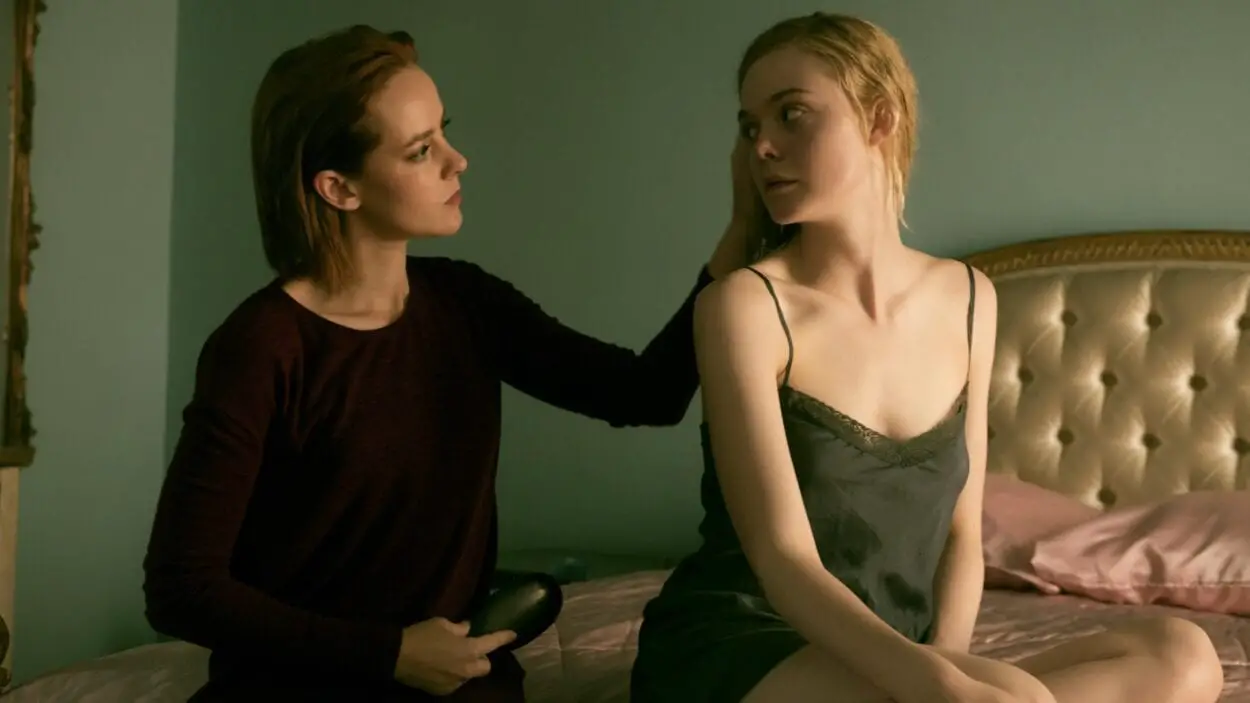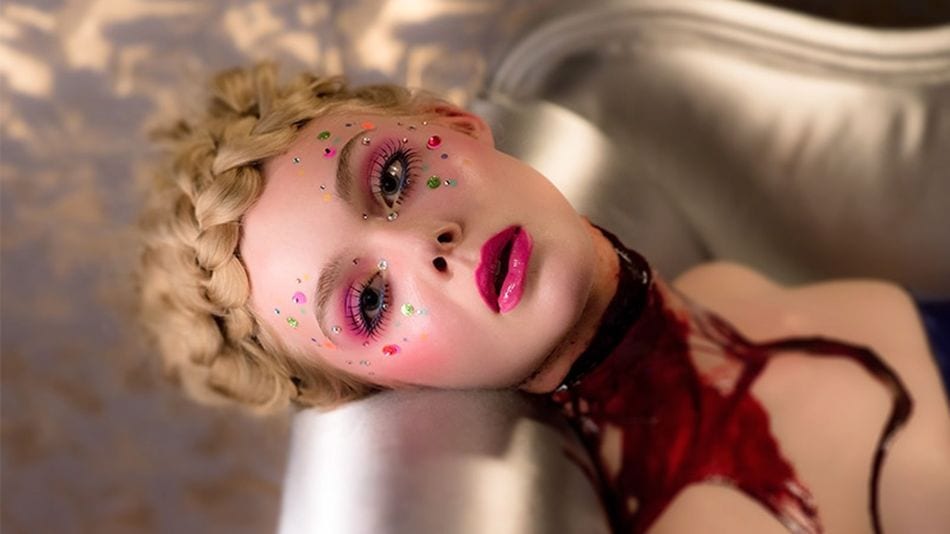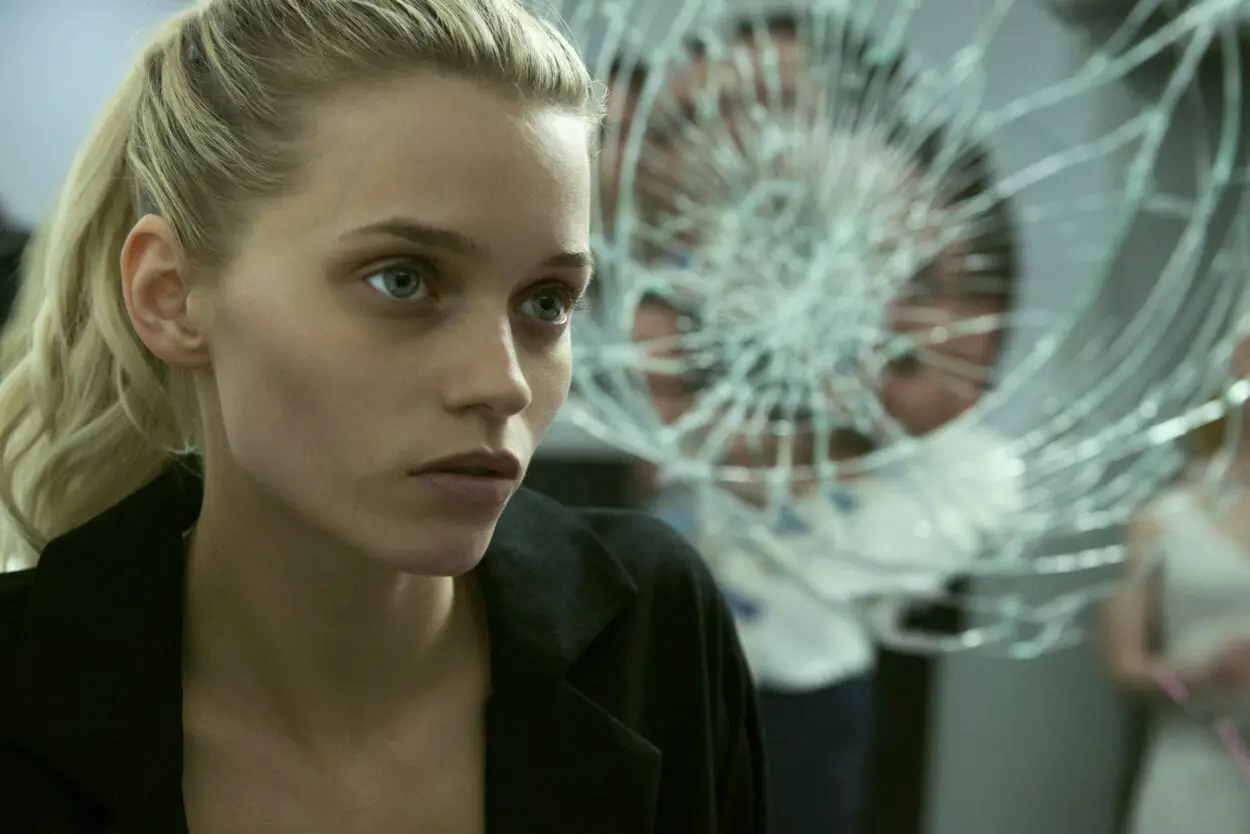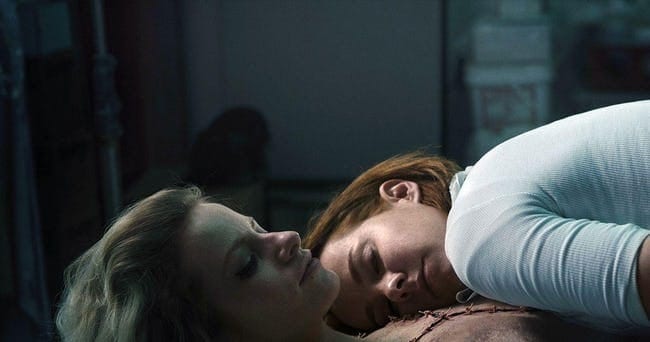The Neon Demon (2016), starring Elle Fanning, is bright, sensual, intriguing, and disturbing. Being only the second film that Refn has written, directed, and produced over his career (the other being Bleeder, 1999), The Neon Demon feels personal and intimate. Critical reception noted and applauded this depth and sensuality, but some viewers were unhappy about some of the more controversial and jarring aspects of the story.
The movie follows Jesse (Elle Fanning), a young girl who wants to be a model. We watch her begin her journey by moving to Los Angeles, where she meets a range of interesting people and discovers how dark the industry can be.
Refn typically directs action and crime thrillers, so this step into fantasy, horror, and social commentary was something relatively new. He co-wrote the screenplay and continued to evolve the tale throughout filming, working closely with Fanning throughout the process. Some of the famous scenes—such as Jesse kissing her reflection—were improvised on set. This is Refn’s only film where the protagonist is female, and you can almost sense the exploratory nature surrounding femininity in some scenes such as this one.
After its release, there was a lot of controversy around this film. We will discuss the story and its messages, and then take a closer look at some specific scenes that caused controversy in and of themselves.

Jesse is only 16 when she moves to LA, a reflection of how the industry claws away at the youth of girls. This choice seems very deliberate and illustrates how early on the pressure of beauty infiltrates itself to the fore of young minds. She is keen to pursue a career in modeling, but she is a little shy and innocent, which initially holds her back.
The film is a commentary on how young women see the beauty industry and the dangers of being over-zealously obsessed with fashion. We watch Jesse meet her peers, discover a narcissism within herself, and become absorbed into the beauty world. As the film progresses, we reach a point where the competitiveness of the girls becomes literally dog-eat-dog. There are numerous scenes depicting women being physically pitted against each other and degrading one another. This is behavior they are learning from their superiors, who speak to them in a condescending way and treat them with little respect in order to intimidate them during the hiring process.
While this all starts out as one might expect, as we enter the second half of the film things take a turn. Jesse is introduced to Gigi (Bella Heathcote) and Sarah (Abbey Lee), two models, by her makeup artist Ruby (Jena Malone). The two girls pick her apart immediately, marveling at her natural beauty and harassing her about aspects of her body and her personal life. It is immediately clear that they are both very jealous of her, and despise her innocence and youth because it is unattainable for them.
In one scene, Sarah says to Jesse, “people see you, they notice. Do you know how lucky you are? I’m a ghost”. It is clear from the offset that both the girls are jealous of Jesse, and this is where their cruelty and rudeness comes from. Although they are both already models, neither of them have the natural beauty of Jesse, with Gigi even boasting about how much plastic surgery she undergoes and referring to herself as “bionic”. Both models are obsessed with physical appearance and adore Jesse’s.

This contrasts with how Ruby sees her, however. Ruby is enchanted by Jesse and her beauty but is appreciative rather than jealous. As she is not a model herself, there is no competition between the two women.
After Jesse meets Gigi and Sarah, the film takes a turn into much darker territory. As the situation between the aspiring models’ spirals, things become sinister. Jesse ends up staying with Ruby because of issues with her accommodation at a local motel.
Because of their jealousy towards Jesse, Gigi and Sarah begin chasing her around Ruby’s house, threatening her with a knife and cornering her outside, by the empty pool. Ruby then comes out and slowly walks up to Jesse, before pushing her into the empty pool. There is a drop of what looks like at least two meters to the bottom of the pool, and Jesse hits the bottom hard.
Ruby’s previous lack of jealousy towards Jesse makes her pivotal action seem out of place and more shocking. While we can almost expect this from Gigi and Sarah, Ruby—although sexually aggressive towards Jesse as a result of her fascination with her—did not seem to be a threat to her life in the way the models might be.
The scene that ensues can only be described as incredibly artistic. Jesse lays in the pool, twitching, clearly paralysed. There is no blood on her skin or clothes, only seeping from underneath her. As the camera rests on her she is trembling and looks helpless. She looks innocent and angelic as she dies; her skin is very pale and her eyes are bright. She is everything a stereotypical angel would be.
Ruby and the two girls climb down into the pool wielding knives, and they eat her. Jealous of her beauty and her quick success, they want her essence within themselves.
The cannibalism in this scene is not shown on-screen, but it is strongly implied and it is clear to audiences what has happened. Immediately afterward, the two models shower together and rinse the blood off themselves. It is not until later scenes that the true horror of cannibalism is shown in detail.
While there is a reference to cannibalism earlier on, it’s easy for it to be misinterpreted, rendering this scene still a shock. In the bathroom at a casting audition, Sarah and Jesse talk. Jesse hurts her hand and Sarah sucks the blood from her palm. In hindsight, it is clear that Sarah deliberately hurt Jesse, and the suck was more of a bite due to her cannibalistic tendencies. However, on the first watch, it screams more of weirdness than an actual depiction of cannibalism, and it is only later that you realise what you should have seen all along. The Neon Demon warns us about narcissism, but it doesn’t warn us about cannibalism until it is too late.
This hyperbole about the lengths women will go to quieten their jealousy of other women is extravagant, but crucial to the mood of the film. Depicting the models purely as jealous is not something new to audiences, and would probably not have brought much attention to the movie. This dramatic depiction allows us to consider the fuller extent of what these attitudes and emotions can do to people, and how damaged you can become when jealousy is permanently at the fore of your mind.

Later on in the movie, Gigi is modeling for a photographer at his home. There is a very dark, satirical feeling to the scene as Sarah, who is there to support Gigi, tells a third girl at the shoot that she “ate” her competition. In this scene, it is obvious that Gigi is feeling uncomfortable, but Sarah doesn’t lose her cool and her expression stays blank. The photographer in charge of the shoot fires this other girl once he notices Sarah, and hires Sarah in her place. She remains cold and emotionless.
During the shoot, Gigi starts to look unwell and runs inside. We hear her gasping and choking, and Sarah walks over to find her and watches as she chokes up one of Jesse’s eyes. Instead of looking disturbed, Sarah looks nonchalant. As the scene progresses, Gigi gasps “I need to get her out of me!” and stabs a pair of scissors into her abdomen in desperation, tearing her stomach apart until she very quickly passes out and dies from the blood-loss. Sarah is still watching on without a hint of emotion. She walks over, picks up the eye, eats it herself, and returns to her shoot.
I can understand why this is controversial. The bold display of cannibalism and violence is disturbing, especially in a film that sets itself up as more of a thriller/drama. However, this nonchalance very clearly represents the fashion industry and how people, especially young women, are numbed to the violence that happens to their bodies and in their minds. The shock of this scene when you’re not expecting it makes it all the more impactful, and, if the desired effect was memorability, it was a success.
Sarah cares more about being beautiful and about her jealousy towards Jesse than she cares about the disturbing scene before her and the suicide of her ‘friend’. This damage has occurred within her because of the way the beauty industry has treated her. She has learned that to be successful she must be cold and hard and perfect and that these things matter more than love or friendship or terror.
While it is easy to understand why this strong depiction can make audiences uneasy, this unease is necessary in order to convey the message in the way it was intended. Without the additional horror and dramatism of the movie it would risk becoming weaker and blending in with chick-flick style titles. Making this film artistic and horrifying makes it stand out much more, and sends home its messages much more powerfully than if it had been told as a simple narrative about an aspiring model. As it is, there is much more to this film than its social commentary, and I see this as a massive credit to its writers, director, and actors.
There is a lot of artistic foreshadowing to be found in this story. At the beginning of the film, Jesse is modeling covered in blood for a photoshoot. Considering how she dies—also in a bed of blood, but with none tarnishing her face—this is an artistic, deliberate choice. Additionally, a few scenes before she is pushed to her death, Jesse is standing on the end of the diving board above the empty pool, and we are already worried about her safety. Because of this scene, we feel much more afraid for her when she is cornered outside, and this information allows the audience to feel more involved in the story as we watch the girls gang up on Jesse.

Refn, when speaking about this film, stated that “it’s very easy to be critical of anything with beauty—to mock, or call it superficial. But beauty is a very complex thing; it says a lot about our vanity, our narcissism, our ego, and that we are not born equal”. This message is abundantly clear as the movie progresses. This is not just a story about a girl, it is a story about society. Refn gives us horror, commentary, surprise, and art. The representation shows beauty as cruel, but also as something that can be attainable, intelligent, and powerful.
The film is very arty as a whole. As well as the exquisite lighting and colours throughout and the artistic foreshadowing about Jesse’s future, the makeup and costumes tell their own story. When we first meet Jesse, she has rosy cheeks, a plump face, youthful beauty, and a perceived innocence about her. Her makeup matches this—she wears pastel eyeshadows, blush, and there are no harsh eyeliners or lipsticks.
However, as she begins to navigate through the fashion world, her makeup becomes harsher and bolder. We move away from emphasising her pink cheeks and big eyes and start to see bold lines and bright colours and she contours away some of her face. This stylistic choice fits with the increasing depth of the story and represents the internal changes that Jesse goes through growing up in such a harsh environment. Subtly, we are perceiving her as bolder and harsher physically as she becomes these things on the inside. The scene that depicts this best takes place during one of her shoots. Jesse is wearing a bright, shiny lip gloss, and looking at herself in multiple mirrors all attached to one another. She begins kissing her reflection, a visual representation of how narcissistic she has become.
Other characters are also depicted further through the makeup that they wear. Sarah, for example, is always wearing harsh makeup, dark colours, bold lines. The only exception is the casting audition scene. Sarah is wearing little or no makeup and looks damaged and fragile. This stark contrast to the way she presents herself in every other scene emphasises the toll this kind of competition has on its applicants. Even Sarah, arguably the mentally strongest character of the entire movie, is torn apart by the vulnerability, jealousy, and low self-worth in these scenes. We are being shown that nobody can escape the bullying and shame that comes from a situation like this.

The message is very clear—this film gives us a warning about the competitive industry, negative body image, selfishness, greed, and—perhaps most importantly—how societal expectations can build immense pressure upon those trying to meet them. This film joins a larger conversation about the effect of beauty-related pressure, the unachievable expectations on women and girls, and the impact this can have on both their relationship with themselves and their relationships with others.
There is an argument to be had regarding whether or not the beauty industry gave Jesse these traits, or if it just exposed them from inside her. Although either interpretation is valid, the point stands that it is only once she enters the world of modeling that this darkness and callousness is exposed.
This in itself is not particularly controversial. However, the way the story is told—with cannibalism, vicious representations of models, and the involvement of necrophilia—creates a debate about whether or not this is a fair depiction of the women in these industries. Perhaps in trying to illuminate the issues these women face, the film has overstepped into painting them as the villains, rather than helping us to focus on the wider picture.

Aside from this debate, there was one scene, in particular, that seems to have stirred up controversy. This final point of controversy in The Neon Demon comes from a scene about midway through the movie where Ruby goes to work at her day job, a mortuary, and masturbates over a dead body whilst fantasising about Jesse.
This scene conveys the girl’s attraction to one another—throughout the scene cuts to Jesse on Ruby’s couch, also masturbating—but does so in a way that is shocking and perhaps unnecessary. If the scene was done this way to be deliberately shocking it certainly achieved this goal. But is that why Refn structured the scene like this? Or was the inclusion of Ruby’s necrophilia intended to have a deeper purpose?

It is possible that this was supposed to warn us about how dangerous Ruby is, or to display another artistic foreshadowing of Jesse’s death. It’s possible even that this scene was included to simply indulge the quirky, twisted direction the movie was beginning to take. It certainly comes at the turning point when the film drifts away from typical modeling cattiness to something much more. But if any of these messages were intended, this was lost on audiences. The shock and the horror of the scene itself detracts from any deeper meaning, especially initially, making it obsolete as a plot device and missing the mark.
Because the scene was so unexpected, it is apparent straight away that some viewers would take issue with it. The Neon Demon was not marketed as a necrophilic movie, so audiences were not prepared for this. That being said, the strangeness that is already taking place in the film before this scene goes some way towards setting it up, and, ultimately, it isn’t particularly focal to the narrative of the story so the mass focus on this scene is a little unwarranted.
Despite the weirdness and controversy, the main takeaway from The Neon Demon for me is the comment it makes on the fashion industry. We watch a young girl get pulled into this unfamiliar world of jealousy and narcissism until it—quite literally—chews her up and spits her back out. This is a warning to all of us about the damage and the destruction our obsession with fashion and aesthetics can cause, and how our fragile and narrow visions of beauty are destroying us. It is a truly artful piece and one which stayed with me long after I watched it. The Neon Demon warns us about narcissism, and shocks us with cannibalism



